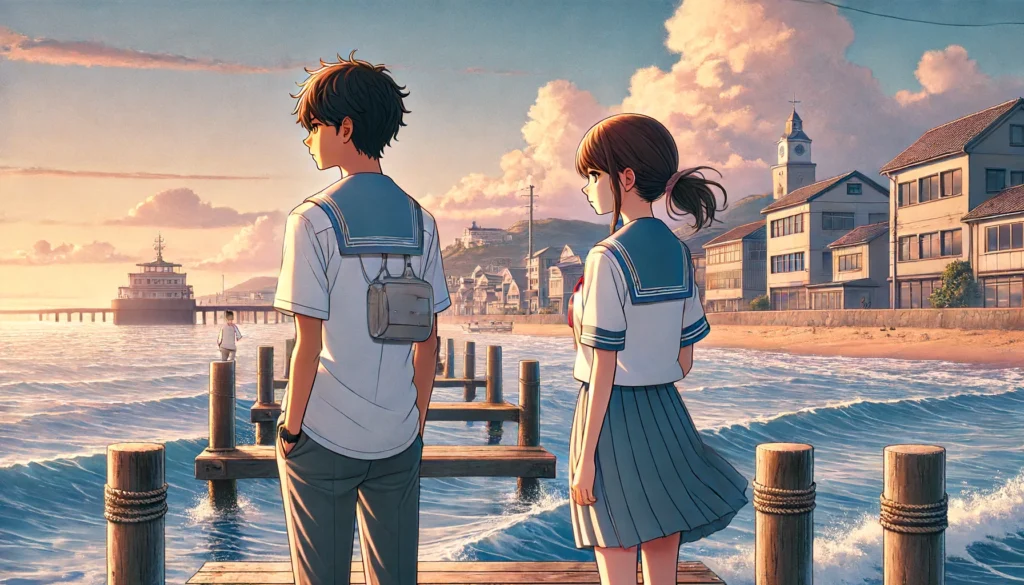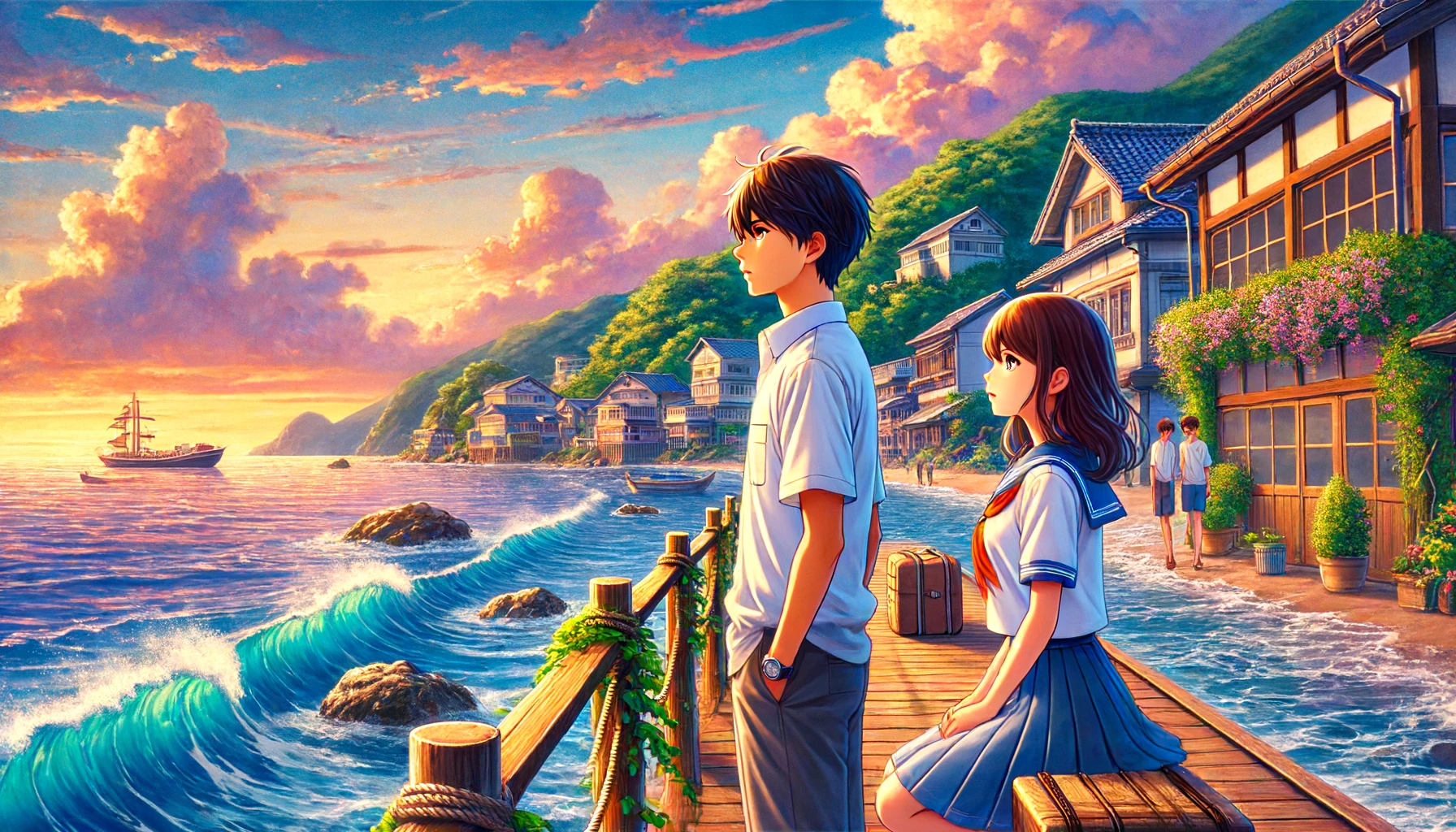
Table of Contents
Introduction
In the realm of anime, Studio Ghibli is renowned for its masterpieces, and while “The Ocean Waves” may not be as universally celebrated as some of the studio’s other works, it holds a special place in the hearts of many fans. Released in 1993 as a television film, “The Ocean Waves” (Umi ga Kikoeru) was directed by Tomomi Mochizuki and represents a significant departure from Studio Ghibli’s more fantastical narratives. This coming-of-age story delves into the complexities of youth, friendship, and love. This SEO-optimized review will explore the themes, animation, characters, and cultural impact of “The Ocean Waves,” providing a comprehensive analysis of this often-overlooked gem.
Plot Summary
“The Ocean Waves” is set in the bustling city of Kochi on Shikoku Island and follows the story of Taku Morisaki, a high school student, and his best friend, Yutaka Matsuno. The arrival of a new student, Rikako Muto, from Tokyo disrupts their lives. Rikako is beautiful, intelligent, and enigmatic, but her aloof and sometimes abrasive nature isolates her from her peers.
Taku becomes unwittingly entangled in Rikako’s life when she borrows money from him for a trip to Tokyo. This trip becomes a pivotal moment in the film, revealing the vulnerabilities and hidden depths of Rikako’s character. The story is narrated from Taku’s perspective, reflecting on these events two years later during a college reunion. The narrative unfolds as a series of flashbacks, exploring the dynamics of their relationships and the impact of these formative experiences.
Themes and Symbolism in The Ocean Waves
“The Ocean Waves” is rich with themes and symbolism, making it a poignant and reflective cinematic experience. One of the central themes is the tumultuous nature of adolescence. The film captures the raw emotions, misunderstandings, and fleeting moments that define teenage years. Taku’s journey is marked by confusion, jealousy, and longing, emotions that resonate with anyone who has navigated the complexities of youth.
The ocean serves as a recurring symbol throughout the film. It represents the passage of time and the constant ebb and flow of life’s experiences. The title itself, “The Ocean Waves,” suggests the idea of memories washing over us, shaping who we are. The waves symbolize both the tranquility and turbulence of Taku’s emotions and relationships.
Another significant theme is the concept of understanding and empathy. The characters’ interactions highlight the difficulty of truly understanding another person’s experiences and emotions. Rikako’s struggles are gradually unveiled, challenging Taku and the audience to look beyond her exterior and empathize with her situation.
Character Analysis
Taku Morisaki, the protagonist, is a relatable and introspective character. His reflective narration adds depth to the story, allowing viewers to see his growth and self-awareness. Taku is a loyal friend and a compassionate individual, but his journey is marked by moments of uncertainty and self-doubt. His evolving relationship with Rikako forces him to confront his own feelings and assumptions.
Rikako Muto is a complex and multi-dimensional character. Her initial portrayal as aloof and independent gradually reveals layers of vulnerability and loneliness. Rikako’s struggles with her parents’ divorce and her displacement from Tokyo to Kochi are central to her character development. She is a catalyst for Taku’s personal growth, challenging him to see beyond appearances and understand her pain.
Yutaka Matsuno, Taku’s best friend, provides a contrasting perspective on the events. His easygoing and supportive nature highlights the strength of his friendship with Taku. Yutaka’s own feelings for Rikako add another layer of complexity to the narrative, creating a subtle love triangle that influences the dynamics between the characters.
Animation and Visual Style
Studio Ghibli’s animation in “The Ocean Waves” is characterized by its simplicity and realism. Unlike the fantastical worlds of Miyazaki’s films, “The Ocean Waves” is grounded in the everyday life of high school students. The animation captures the essence of 1990s Japan, from the bustling streets of Kochi to the serene coastal landscapes.
The film’s visual style is understated yet effective, with a focus on character expressions and body language. The use of natural lighting and muted color palettes creates a sense of nostalgia, perfectly complementing the reflective nature of the narrative. The animation may not be as visually spectacular as other Ghibli films, but it excels in conveying the subtleties of human emotion and interaction.
Soundtrack and Audio
The soundtrack of “The Ocean Waves,” composed by Shigeru Nagata, plays a crucial role in setting the film’s tone. The music is both soothing and melancholic, reflecting the film’s themes of nostalgia and introspection. The use of piano and string instruments creates a delicate and evocative soundscape that enhances the emotional depth of the story.
The film’s audio design also deserves praise for its attention to detail. The ambient sounds of the city, the gentle lapping of the ocean waves, and the murmur of school life contribute to the film’s realistic portrayal of everyday experiences. The voice acting is subtle and natural, with performances that bring the characters’ emotions to life.
Cultural and Historical Context
“The Ocean Waves” provides a snapshot of Japanese youth culture in the early 1990s. The film explores the societal pressures and expectations placed on high school students, including the competitive nature of academics and the challenges of transitioning to adulthood. The depiction of high school life, from classroom interactions to school trips, offers a glimpse into the daily experiences of Japanese teenagers.
The film also touches upon the impact of divorce and family dynamics on young people. Rikako’s struggles with her parents’ separation and her move to a new city reflect broader societal issues and the emotional toll of family discord. “The Ocean Waves” presents these themes with sensitivity and realism, making it a relatable and insightful film for audiences of all backgrounds.
Reception and Impact
Upon its release, “The Ocean Waves” received mixed reviews from critics and audiences. Some praised the film for its realistic portrayal of teenage life and its subtle storytelling, while others felt it lacked the visual grandeur and fantastical elements typical of Studio Ghibli films. However, over time, the film has gained a dedicated following and is appreciated for its unique place in Ghibli’s filmography.
“The Ocean Waves” is often regarded as a hidden gem within Studio Ghibli’s repertoire. Its understated approach and focus on character development set it apart from the studio’s more well-known works. The film’s impact extends beyond its initial reception, influencing subsequent coming-of-age stories in anime and contributing to the genre’s evolution.
Conclusion
“The Ocean Waves” is a poignant and reflective film that captures the essence of adolescence with sensitivity and realism. Directed by Tomomi Mochizuki and produced by Studio Ghibli, the film offers a unique and introspective narrative that stands out within the studio’s acclaimed body of work. Through its exploration of themes such as youth, friendship, and understanding, “The Ocean Waves” resonates deeply with viewers, reminding us of the complexities and beauty of growing up.
For fans of Studio Ghibli and those new to its films, “The Ocean Waves” provides a refreshing and thought-provoking experience. Its rich narrative, nuanced characters, and evocative soundtrack make it a must-watch for anyone interested in the human condition and the journey of self-discovery. As we navigate the waves of our own lives, this film encourages us to reflect on the memories that shape us and the connections that define us.
Watch Now: Link 1
Download The Ocean Waves Movie
FAQ
- What is the plot of “The Ocean Waves”?
- “The Ocean Waves” (Umi ga Kikoeru) is a coming-of-age story that revolves around high school students Taku Morisaki and his best friend Yutaka Matsuno. Their lives are disrupted by the arrival of Rikako Muto, a transfer student from Tokyo. The film explores themes of friendship, unrequited love, and the challenges of adolescence as Taku and Yutaka navigate their complex feelings towards Rikako (Wikipedia) (MyAnimeList.net).
- Who directed “The Ocean Waves” and what makes it unique in Studio Ghibli’s lineup?
- Directed by Tomomi Mochizuki, “The Ocean Waves” is unique because it was the first Studio Ghibli film not directed by the studio’s founders, Hayao Miyazaki or Isao Takahata. This film was also an attempt to allow the younger staff of Studio Ghibli to take the lead on a project (Wikipedia) (Otaku USA Magazine).
- What are the main themes explored in “The Ocean Waves”?
- The main themes of “The Ocean Waves” include the tumultuous nature of teenage relationships, the bittersweetness of unrequited love, and the personal growth that comes from understanding and empathy. The film also delves into the impact of family dynamics, particularly the effects of divorce, on young people (MyAnimeList.net) (Anime News Network).
- How was “The Ocean Waves” received by critics and audiences?
- Upon its release, “The Ocean Waves” received mixed reviews. Some critics praised its realistic portrayal of teenage life and subtle storytelling, while others felt it lacked the visual grandeur and imaginative elements typical of other Ghibli films. Over time, however, it has gained a dedicated following and is appreciated for its unique place in Studio Ghibli’s filmography (Anime News Network) (Otaku USA Magazine).
- What is the significance of the ending in “The Ocean Waves”?
- The ending of “The Ocean Waves” is open-ended, leaving several questions unanswered. It highlights the transitory nature of adolescence and the bittersweet reality of fleeting relationships. Some interpret the ending as a reflection of Taku’s growth and maturity, as he embarks on a journey to find Rikako but ultimately comes to terms with letting go and moving forward (Endante).
For more detailed information, you can visit the sources used in compiling these FAQs: Wikipedia, MyAnimeList, Anime News Network, Otaku USA Magazine, and Endante.
